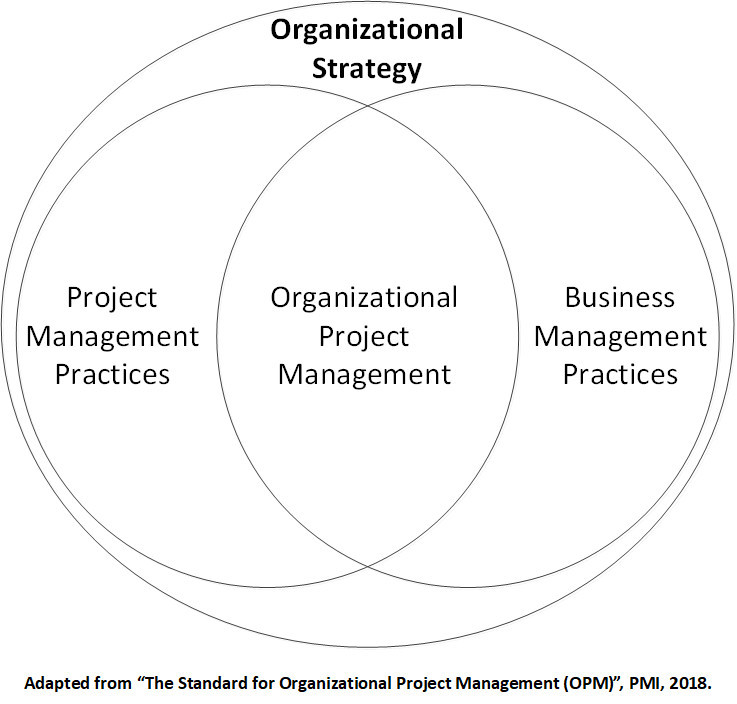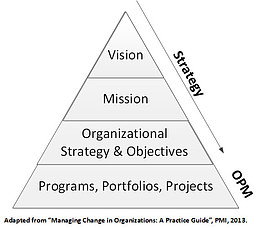The only thing for certain is change. When investing in a project execution infrastructure, it is important to build that capability to support change. The capability itself needs to be adaptable and can be tailored.
This post looks at what Organizational Project Management is, and how it can become a strategic capability for the right organizations.
What Is Organizational Project Management?
 Organizational Project Management is a foundational standard published by the Project Management Institute (PMI), which officially calls it “The Standard for Organizational Project Management“.
Organizational Project Management is a foundational standard published by the Project Management Institute (PMI), which officially calls it “The Standard for Organizational Project Management“.
In the words of the PMI:
“Organizational project management (OPM) is the framework used to align project, program, and portfolio management practices with organizational strategy and objectives, and customizing or fitting these practices within the organization’s context, situation, or structure.”
The graphic at right, adapted from “The Standard for Organizational Project Management (OPM)”, PMI, 2018, shows several component entities and how they are related to one another:
- Organizational Strategy – The C-level driven and approved strategy for the overall organization and its components.
- Project Management Practices – The project management standards which have been adopted and are being applied consistently across the organization.
- Business Management Practices – The common business practices, as documented, for example, in the organization’s business model, by which business is executed.
- Organizational Project Management – At the intersection of Project Management Practices and Business Management Practices, the strategic and adaptable capabilities for executing projects to support business practices. OPM can change as required to support strategy adjustments.
This post focuses on how it can be a core strength that remains a steady constant and helps the greater organization adapt to disruptive and continuous change. OPM can help an organization maintain strategic alignment, even when the strategy changes.
Organizational Project Management and Change
How does OPM relate to organizational change? That’s where OPM has the potential to become an adaptable strategic capability.
A core capability for managing programs, portfolios, and projects needs to be adaptable to change. I see this happening in two ways:
- Continuous improvement – Practitioners need to build a continuous process improvement loop into the relationships among program, portfolio, and project management. The unique processes, as tailored for the organization, need to be improved and adapted on a regular basis to remain sharp and relevant.
- Adapting to strategy changes – Strategies will change, and will sometimes result in a pivot in the direction of the organization. The framework for managing projects needs to be tailored to accommodate the potential for major strategic changes.
OPM concepts can help an organization in many ways. The key, mentioned in both points above, is to tailor OPM practices to the size and needs of the organization. This raises the practice of project management to an organizational perspective, positioning it as a strategic strength.
—————————————-
I recommend these PM templates (paid link):

—————————————-
Most important to supporting change is the ability to build in adaptability. That means to tailor OPM in such a way that it is adaptable to change as frequently and rapidly as needed, depending on the competitive environment and other environmental factors.
Strategy and OPM
 The graphic at right shows OPM within the overall context of strategy and project management within an organization, adapted from ““Managing Change in Organizations: A Practice Guide”, PMI, 2013”.
The graphic at right shows OPM within the overall context of strategy and project management within an organization, adapted from ““Managing Change in Organizations: A Practice Guide”, PMI, 2013”.
Particularly notable is the arrow from Strategy to OPM, which shows input from strategy to portfolios, programs, and projects.
I believe that the more interaction there is between strategy and execution, the better. This can be helped by breaking down barriers between strategy and project management.
Here are four ways that can help break down the barriers:
- Organization structure – Structuring the organization for ease of communication is important. That means quality of communication, speed, timing, and appropriate triggers. Structuring relationships accordingly can facilitate this.
- Cross training – Project, program, and portfolio managers can become more familiar with the strategic approaches of the organization, and strategic thinking and adaptability in general. This will hep with communication, construction of the right metrics, keeping initiatives on track, and pivoting more quickly when necessary.
- Cross pollination – Rotating people into various positions on both side of the line between strategy and execution can help. This will bring strategic thinking to the execution side, and a greater appreciation for execution on the strategy side. Greater alignment and stronger performance would be the expected results.
- Streamlined processes – Make the processes for program, portfolio, and project management as nimble as possible, driven by the potential need for adaptability the face of change.
For example, it is helpful for everyone involved to understand something about the nuances of a low cost, differentiation, or hybrid strategies, and how they relate to the organization’s strategy. It is also helpful to understand something about the strategic context within which the organization operates. These can enable greater adaptability and resilience when conditions change.
—————————————-
I recommend these strategy resources (paid link):
—————————————-
Advantages and Disadvantages of OPM
 Organization Project Management is powerful and well-structured foundational standard but does not necessarily apply to every situation.
Organization Project Management is powerful and well-structured foundational standard but does not necessarily apply to every situation.
Here are some advantages and disadvantages:
Advantages:
- Provides a well-structured and consistent approach to managing projects across an organization and its operational business units.
- Provides a potential competitive advantage in the marketplace, whether the business is project-based or executes internal projects.
- Provides a structure to leverage in the face of change, that can provide some consistency and yet be pliable as priorities shift.
Disadvantages:
- Requires a substantial size in terms of numbers of projects, financial impact, or other measures, to be determined specifically by each organization
- May provide too much structure for the situation; needs to be assessed for the specific organization
- Costly to implement; it’s like a capital investment to be considered based upon expected returns
Formal OPM appears to be most appropriate for larger organizations – but it needs to be evaluated for each situation. I see more agile and lean approaches such as lean innovation management working better is smaller and more startup oriented businesses. However, more stable – and typically larger – businesses can leverage OPM to build more resiliency in the face of marketplace and disruptive change.
The advantages all apply, but only in the right situation. The disadvantages outlined above all can be mitigated, also depending on the situation. A good approach is to consider an optimal tailored approach for your organization, and perform a cost-benefit or ROI analysis.
Conclusion
This post looked at Organizational Project Management as a potential strategic capability, and how it can support change within an organization, and its structure must itself be adaptable to change.
